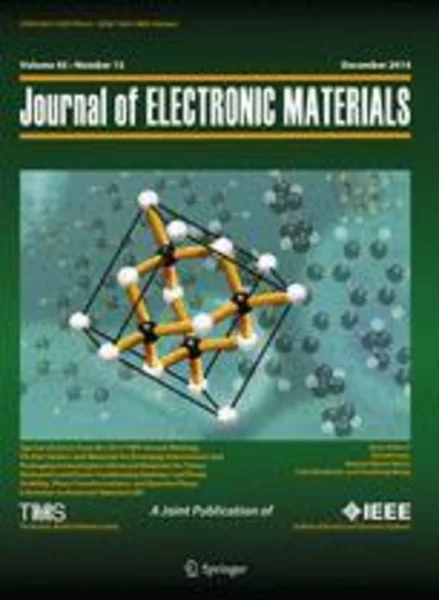-
influence of vanadium on the defect structure and thermoelectric properties of gete
جزئیات بیشتر مقاله- تاریخ ارائه: 1392/07/24
- تاریخ انتشار در تی پی بین: 1392/07/24
- تعداد بازدید: 895
- تعداد پرسش و پاسخ ها: 0
- شماره تماس دبیرخانه رویداد: -
the development of new thermoelectric materials based on gete is associated with reducing the hole concentration and thermal conductivity. the objects of the present study are gete-based solid solutions in the ge-v-te ternary system. the goal of the work is to study the character of the change in the structure, mechanical and thermoelectric properties of gete under introduction of vte. the electrical conductivity σ, seebeck coefficient s, and hall coefficient r h were measured in the range of 300 k to 850 k on cast samples and samples prepared by hot pressing; the thermal conductivity λ was measured at room temperature. it was found that the dependences of the unit cell parameters, microhardness, σ, r h, λ, and s on the vte content exhibit nonmonotonic behavior. the experimental results were interpreted taking into consideration the complex mechanisms of defect formation in the gete crystal lattice under introduction of vte, the existence of nonstoichiometric vacancies, and percolation effects. it was established that introduction of vte into gete leads to a significant decrease in λ and hole concentration p. the maximum room-temperature values of thermoelectric power factor p and thermoelectric figure of merit z corresponded to ~2 mol.% vte. with increasing temperature up to ~550 k, p increases, and the maximum value of p is shifted to ~3 mol.% vte. the values of p and z obtained for the cast and pressed samples were practically the same.
مقالات جدیدترین رویدادها
-
استفاده از تحلیل اهمیت-عملکرد در ارائه الگوی مدیریت خلاقیت سازمانی و ارائه راهکار جهت بهبود
-
بررسی تاثیر ارزش وجوه نقد مازاد بر ساختار سرمایه شرکت های پذیرفته شده در بورس اوراق بهادار تهران
-
بررسی تأثیر سطح افشای ریسک بر قرارداد بدهی شرکت های پذیرفته شده در بورس اوراق بهادار تهران
-
بررسی تأثیر رتبه بندی اعتباری مبتنی بر مدل امتیاز بازار نوظهور بر نقد شوندگی سهام با تأکید بر خصوصی سازی شرکت ها
-
تأثیر آمیخته بازاریابی پوشاک ایرانی بر تصویر ذهنی مشتری پوشاک ایرانی (هاکوپیان)
-
بهینه زاویه آبگیر در قوس 90 درجه همگرا در حضور ذرات شناور چوبی
-
مروری انتقادی بر نحوه ارزیابی سرمایه فکری
-
مقایسه تجربی رفتار خارج از صفحه سقفهای طاق ضربی تقویت شده
-
بررسی توان اکولوژی استان خراسان رضوی برای تثبیت جمعیت و جلوگیری از مهاجرت ها با رویکرد آمایش سرزمین
-
ارزیابی عوامل خطرساز بروز نارسایی حاد کلیه در جراحی آنوریسم آئورت شکمی
مقالات جدیدترین ژورنال ها
-
مدیریت و بررسی افسردگی دانش آموزان دختر مقطع متوسطه دوم در دروان کرونا در شهرستان دزفول
-
مدیریت و بررسی خرد سیاسی در اندیشه ی فردوسی در ادب ایران
-
واکاوی و مدیریت توصیفی قلمدان(جاکلیدی)ضریح در موزه آستان قدس رضوی
-
بررسی تاثیر خلاقیت، دانش و انگیزه کارکنان بر پیشنهادات نوآورانه کارکنان ( مورد مطالعه: هتل های 3 و 4 ستاره استان کرمان)
-
بررسی تاثیر کیفیت سیستم های اطلاعاتی بر تصمیم گیری موفق در شرکتهای تولیدی استان اصفهان (مورد مطالعه: مدیران شرکتهای تولیدی استان اصفهان)
-
آینده پژوهی در معماری تبیین رویکردهای آینده پژوهانه در حوزه طراحی مسکن
-
نگاهی به بررسی پیامدها ، آثار و تبعات اجتماعی سوءاستفاده از زنان
-
تحلیل عوامل تاثیرگذار بر فطرت
-
بررسی وضعیت حقوقی استفاده ازموشکهای بالستیک توسط ایران و انطباق آن با مقررات بین المللی
-
numerical simulation of impulsive water waves generated by subaerial and submerged landslides incidents in dam reservoirs




سوال خود را در مورد این مقاله مطرح نمایید :